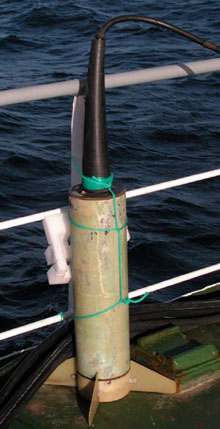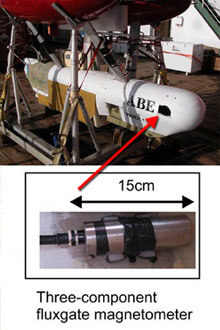The autonomous benthic explorer (ABE) autonomous underwater vehicle (AUV) in its docking cradle. Note the location of the fluxgate magnetometer (indicated by the red arrow). Click image for larger view and image credit.
Magnetic Surveys at Brothers Volcano
August 1, 2007
Bryan W. Davy
Marine Geophysicist
GNS Science
Lower Hutt, New Zealand
During the New Zealand American Submarine Ring of Fire 2007 (NZASRoF’07) expedition the autonomous underwater vehicle (AUV) called ABE (for autonomous benthic explorer) will be used to map Brothers Volcano in detail. Brothers Volcano is a rhyodacite (silicious, explosive) volcano which rises 800 meters (more than 2,600 feet) above the surrounding sea floor to a caldera rim 1,500 m (almost 1 mile) below sea level. The explosive eruption of Brothers Volcano was of sufficient energy and volume to at least partially empty the underlying magma chamber and form the 3x4 kilometer (1.6 x 2.2 nautical mile) collapse caldera, 300 m below the rim. Studies of similar collapse calderas (depressions) on land suggest that much of the caldera would have been filled by pyroclastic (low-density vesicular lavas) deposits formed during the eruption. Several dacite (slightly less silicious than rhyodacite) domes have reformed within the southeastern corner of Brothers caldera.

A surface tow total-field proton magnetometer, which will be towed behind the research vessel (R/V) Sonne on the NZASRoF’07 expedition. Click image for larger view
Brothers Volcano is expected to have large magnetic anomalies, many hundreds of nano-Tesla (a unit of magnetic field strength) in amplitude, sourced within its volcanic lavas. Magnetic anomaly surveying can be used to help identify recent lava flows. The younger and larger the volcanic lava body is, the greater the magnetic anomaly expected to be associated with it. The volcanic domes located in southeastern Brothers caldera are, for instance, expected to preserve a strong magnetic anomaly signature. Other buried lava domes might be revealed by magnetic surveying.
During this expedition, as is the case on many traditional marine geophysical surveys, the R/V Sonne will tow a magnetometer at the sea surface, measuring the magnetic field above the volcano. The volcano, however, lies between 1,500 and 2,500 m below any near-surface towed magnetometer, so the magnetics survey will reveal only very broad, kilometer-scale, magnetic anomaly variations associated with the volcanic structure. Much higher resolution magnetic anomaly information is provided by surveying with ABE.
The ABE caldera surveys will consist of a series of dives, "flying" along parallel lines about 50 m above the volcano and collecting magnetic anomaly measurements (using the palm-sized magnetometer mounted on ABE). It will also collect swath bathymetry, conductivity, temperature, and chemical measurements. The magnetic anomaly measurements will be used to estimate the magnetization of the volcano. That magnetization will be correlated with what we see on the bathymetry and imagery to identify volcanic flow units.
Brothers Volcano is known to have geothermal vent sites within the caldera. The high temperature of this fluid alters the chemistry of the magnetic titanomagnetite minerals within the lavas, converting them to minerals which preserve much less magnetization. Both modern actively venting sites and historical sites, which are no longer venting, can be recognized by the magnetically quiet zones which result from the geothermal alteration.
Sign up for the Ocean Explorer E-mail Update List.

















